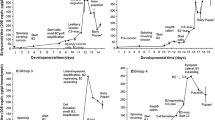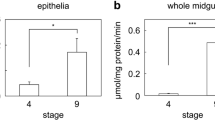Summary
The epidermis of final instar tobacco hornworm larvae,Manduca sexta, becomes committed to pupal differentiation in response to ecdysteroid in the absence of juvenile hormone (JH). Many changes in protein synthetic patterns have been noted during this time (Kiely and Riddiford 1985). To determine which of these changes are caused by ecdysteroid and which are important for the change of commitment, we have incubated larvally-committed epidermis for 24 h with 1 μg/ml 20-hydroxyecdysone (20HE) and 3 μg/ml epoxygeranylsesamole (EGS) (a JH mimic), with 3 μg/ml EGS alone, or in hormone-free medium. Synthesis of larval-specific proteins such as insecticyanin and larval cuticular proteins was reduced to trace amounts or was undetectable after culture with 20HE for 24 h. The larval cuticular proteins that are greatly increasedin vivo on day 3 were not synthesized after exposure to 20HEin vitro. Ecdysteroid increased the synthesis of many of the proteins first seenin vivo on day 3 or during the wandering stage. The synthesis of about half of these latter proteins was inhibited by JH, indicating that they were likely part of the change of commitment. Other proteins that appear at this stagein vivo showed increased synthesis also in hormone-free medium and therefore were independent of the change of commitment.
Similar content being viewed by others
References
Bell RA, Joachim FG (1976) Techniques for rearing laboratory colonies of the tobacco hornworms and pink bollworms. Ann Entomol Soc Am 69:365–373
Bollenbacher WR, Gilbert LI (1982) Neuroendocrine control of postembryonic development in insects. The prothoracicotropic hormone. In: Farner DS, Lederis K (eds) Neurosecretion: molecules, cells, systems. Plenum Press, New York, pp 361–370
Bollenbacher WE, Smith SL, Goodman W, Gilbert LI (1981) Ecdysteroid titer during larval-pupal-adult development of the tobacco hornworm,Manduca sexta. Gen Comp Endocrinol 44:302–306
Guyette WA, Matusik RJ, Rosen JM (1979) Prolactin-mediated transcriptional and post-transcriptional control of casein gene expression. Cell 17:1013–1023
Ivarie RD, O'Farrell PH (1978) The glucocorticoid domain: Steroid-mediated changes in the rate of synthesis of rat hepatoma proteins. Cell 13:41–55
Jones PP (1980) Analysis of radiolabeled lymphocyte proteins by one- and two-dimensional polyacrylamide gel electrophoresis. In: Mishell BB, Shiigi SM (eds) Selected methods in cellular immunology. W. H. Freeman and Company, San Francisco, pp 398–440
Jowett T, Postlethwait JH (1980) Opposing interactions of juvenile hormone and 20-hydroxyecdysone on synthesis ofDrosophila yolk polypeptides and a larval serum protein. Nature 292:633–635
Kiely ML (1982) Temporal programming of epidermal cell protein synthesis during the larval-pupal transformation ofManduca sexta. PhD Thesis, University of Washington
Kiely ML, Riddiford LM (1985) Temporal progamming of epidermal cell protein synthesis during the larval-pupal transformation ofManduca sexta. Wilhelm Roux's Arch 194:325–335
Laskey RA, Mills AD (1975) Quantitative film detection of3H and14C in polyacrylamide gels by fluorography. Eur J Biochem 56:335–341
May FEB, Knowland J (1981) Patterns of protein synthesis in livers ofXenopus laevis during metamorphosis: Effects of estrogen in normal and thyrostatic animals. Dev Biol 82:158–167
McKnight GS (1978) The induction of ovalbumin and conalbumin mRNA by estrogen and progesterone in chick oviduct explant cultures. Cell 14:403–413
O'Farrell PZ, Goodman HM, O'Farrell PH (1977) High resolution two-dimensional electrophoresis of basic as well as acidic proteins. Cell 12:1133–1142
Riddiford LM (1976) Hormonal control of insect epidermal cell commitment in vitro. Nature 259:115–117
Riddiford LM (1978) Ecdysone-induced change in cellular commitment of the epidermis of the tobacco hornworm,Manduca sexta, at the initiation of metamorphosis. Gen Comp Endocrin 34:438–446
Riddiford LM (1981) Hormonal control of epidermal cell development. Am Zool 21:751–762
Riddiford LM (1982) Changes in translatable mRNAs during the larval-pupal transformation of the epidermis of the tobacco hornworm. Dev Biol 92:330–342
Riddiford LM (1984) Hormonal control of sequential gene expression in insect epidermis. In: Hoffmann JA, Porchet M (eds) Biosynthesis, metabolism and mode of action of invertebrate hormones. Springer, Berlin Heidelberg New York, Tokyo, pp 265–272
Riddiford LM, Curtis AT, Kiguchi K (1979) Culture of the epidermis of the tobacco hornwormManduca sexta. Tiss Cult Assn Man 5:975–985
Riddiford LM, Kiely ML, Wolfgang WJ (1985) Hormonal regulation of larval-specific protein synthesis. In: Kurstak E, Oberlander H, Maramorosch K (eds) Invertebrate tissue culture: Developments and applications. Elsevier, Amsterdam [in press]
Riddiford LM, Kiguchi K, Roseland CR, Chen AC, Wolfgang WJ (1980) Cuticle formation and sclerotization in vitro by the epidermis of the tobacco hornworm,Manduca sexta. In: Kurstak E, Maramorosch K, Dubendörfer A (eds) Invertebrate systems in vitro. Elsevier/North-Holland, Amsterdam, pp 103–115
Roberts PE, Willis JH (1980a) The cuticular proteins ofTenebrio molitor. II. Patterns of synthesis during postembryonic development. Dev Biol 75:70–77
Roberts PE, Willis JH (1980b) Effects of juvenile hormone, ecdysterone, actinomycin D, and mitomycin C on the cuticular proteins ofTenebrio molitor. J Embryol Exp Morphol 56:107–123
Willis JH, Regier JC, De Brunner BA (1981) The metamorphosis of arthropodin. In: Bhaskaran G, Friedman S, Rodriguez JG (eds) Current topics in insect endocrinology and nutrition. Plenum Press, New York, pp 27–46
Wolfgang WJ (1984) The basis of structural morphogenesis in the larval cuticle of the tobacco hornworm,Manduca sexta. PhD thesis, University of Washington, Seattle
Wolfgang WJ, Riddiford LM (1981) Cuticular morphogenesis during continuous growth of the final instar larva of a moth. Tiss Cell 13:757–772
Wolfgang WJ, Riddiford LM (1985) The biochemical basis of cuticular morphogenesis in the larva of the tobacco hornworm,Manduca sexta. Der Biol [in press)
Author information
Authors and Affiliations
Rights and permissions
About this article
Cite this article
Kiely, M.L., Riddiford, L.M. Temporal patterns of protein synthesis inManduca epidermis during the change to pupal commitment in vitro: their modulation by 20-hydroxyecdysone and juvenile hormone. Wilhelm Roux' Archiv 194, 336–343 (1985). https://doi.org/10.1007/BF00877371
Received:
Accepted:
Issue Date:
DOI: https://doi.org/10.1007/BF00877371




